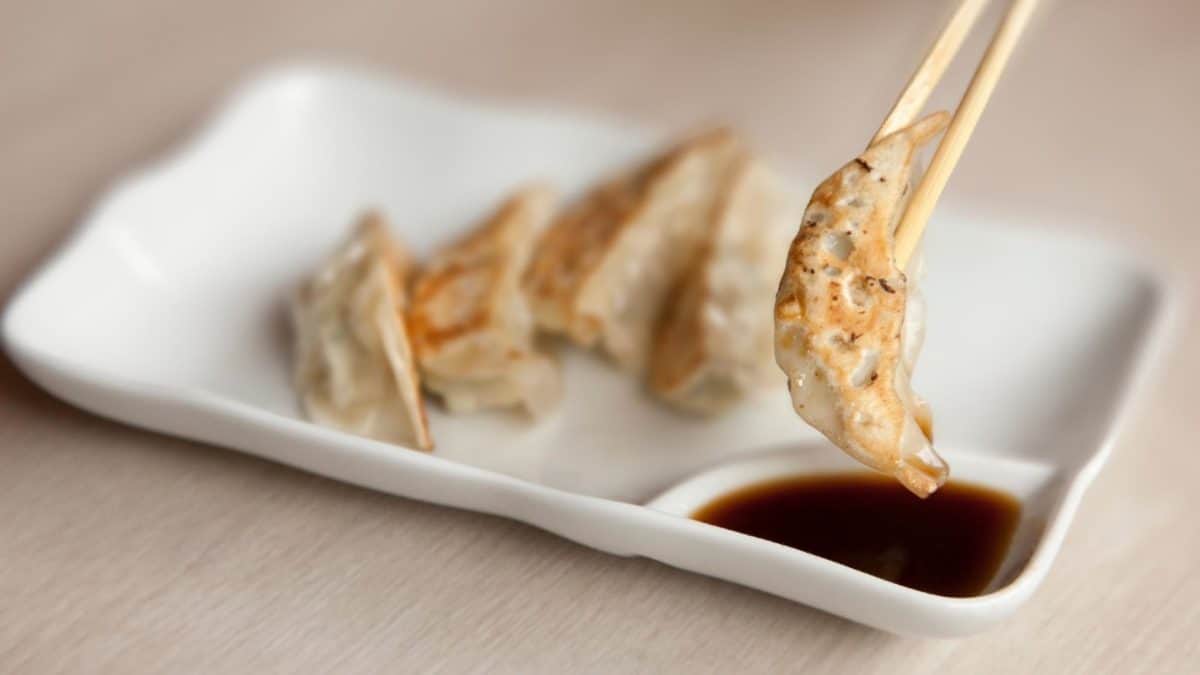Gyoza (餃子): The Japanese Answer To Dumplings
Gyoza are a kind of Japanese dumplings of Chinese origin, called jiaozi.
They typically consist of a ground meat and/or vegetable filling wrapped into a thinly rolled piece of dough, which is then sealed by pressing the edges together or by crimping.
Jiaozi or Gyoza should not be confused with wonton, jiaozi has a thicker skin and a relatively flatter, more oblate, double-saucer-like shape (similar in shape to ravioli), and is usually eaten with a soy-vinegar dipping sauce (and/or hot chili sauce); while wontons have thinner skin and are usually served in broth.

The dough for the jiaozi and wonton wrappers also consists of different ingredients.

Check out our new cookbook
Bitemybun's family recipes with complete meal planner and recipe guide.
Try it out for free with Kindle Unlimited:
Read for freeIn this post we'll cover:
What does “gyoza” mean?
The word “gyoza” is the Japanese way of saying “jiaozi”, the Chinese potstickers gyoza is derived from, and it refers to a type of dumpling that is typically made with ground meat and vegetables wrapped in a thin dough.
What does gyoza taste like?
Gyoza have a very distinct taste that is both savory and slightly sweet. The dough is usually made with wheat flour and water, and it is steamed or boiled until it is cooked through. The filling is typically made with ground pork, cabbage, ginger, garlic, and green onions. When you take a bite of gyoza, you will first taste the doughy wrapper, followed by the savory and slightly sweet filling.
How do you eat gyoza?
There are many different ways to eat gyoza, but the most popular way is to dip them in a sauce made with vinegar, soy sauce, and chili oil. You can also eat them plain, or with a dipping sauce made with soy sauce and rice vinegar.
What are the benefits of eating gyoza?
Gyoza are a great source of protein and they are also low in calories. One gyoza has only about 25 calories, so they are a great option if you are watching your weight.
What’s the origin of gyoza?
Gyoza originated in China and they were originally made with pork. However, the Japanese version of gyoza typically uses ground chicken or beef instead of pork. Gyoza were introduced to Japan during the Second World War, when Japanese soldiers brought them back from their time in China.
What’s the difference between gyoza and shumai?
Shumai is another type of Chinese dumpling that is similar to gyoza. The main difference between the two is that shumai are typically made with pork, shrimp, or chicken, while gyoza are usually made with ground meat and vegetables. Shumai are also generally steamed, while gyoza can be either steamed or fried.
What’s the difference between gyoza and mandu?
Mandu is a type of Korean dumpling that is similar to gyoza. The main difference between the two is that mandu are typically made with beef or pork, while gyoza are usually made with ground meat and vegetables. Mandu can also be either steamed or fried, but they are most commonly boiled.
Where to eat gyoza?
If you want to try gyoza, there are many places that serve them. In Japan, there are many gyoza restaurants, and you can also find gyoza in most Chinese and Japanese restaurants. You can also find gyoza in some Korean restaurants.
Conclusion
Gyoza are great dumplings for when you don’t like the soft doughy ones because the frying makes them crunchy and even more delicious.
Also read: gyoza vs dumplings, how to tell them apart
Check out our new cookbook
Bitemybun's family recipes with complete meal planner and recipe guide.
Try it out for free with Kindle Unlimited:
Read for freeJoost Nusselder, the founder of Bite My Bun is a content marketer, dad and loves trying out new food with Japanese food at the heart of his passion, and together with his team he's been creating in-depth blog articles since 2016 to help loyal readers with recipes and cooking tips.
